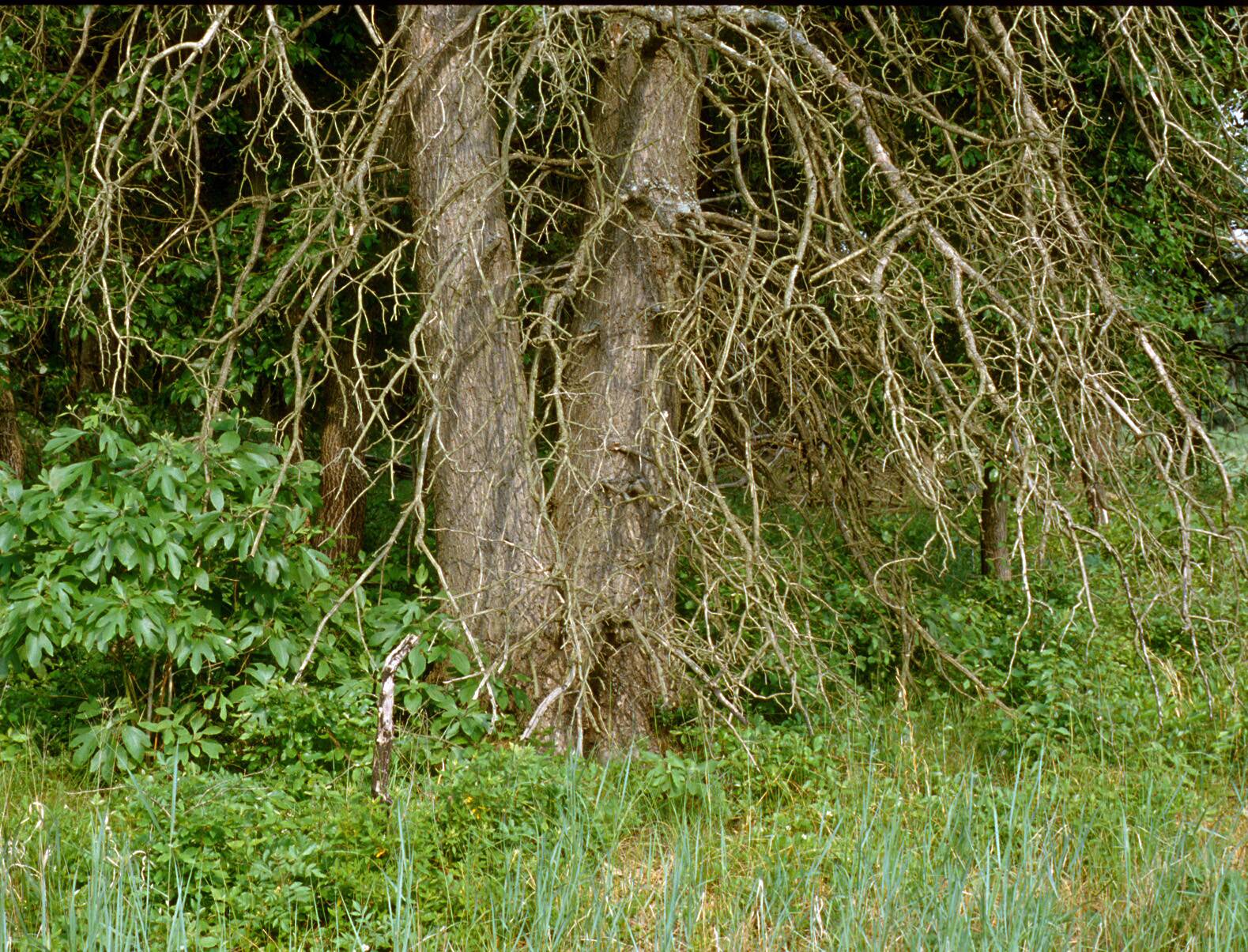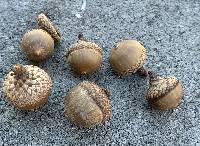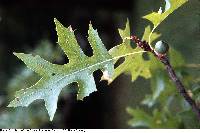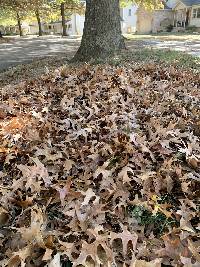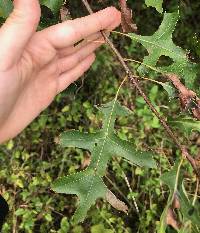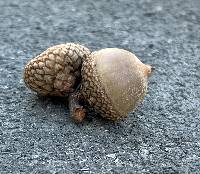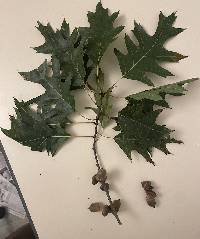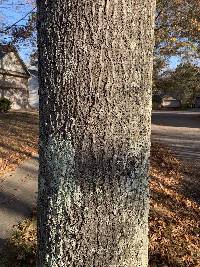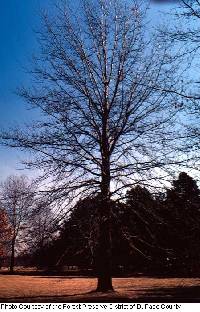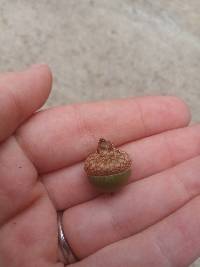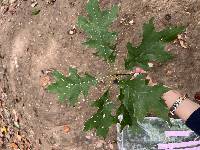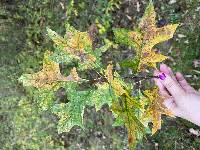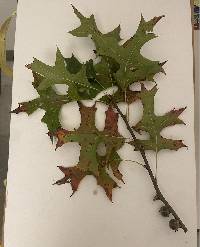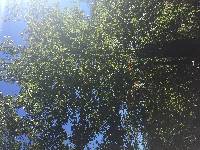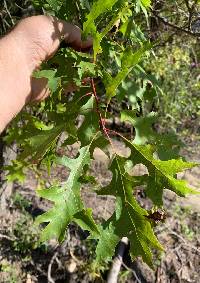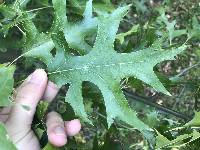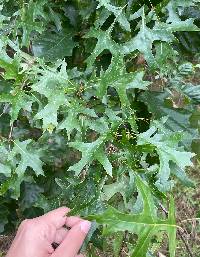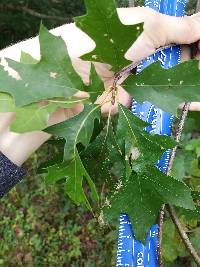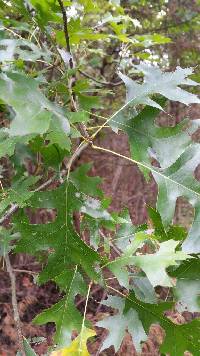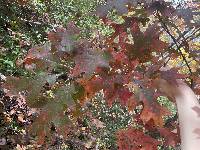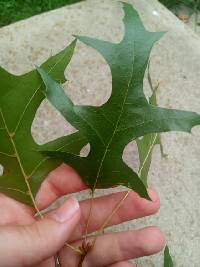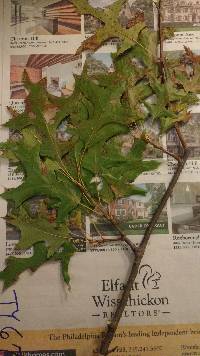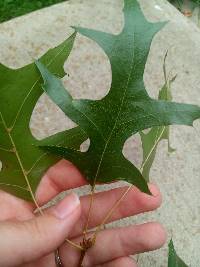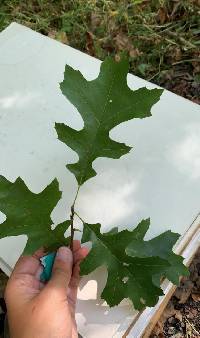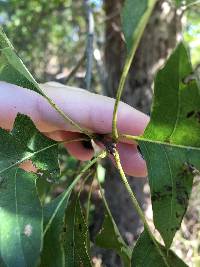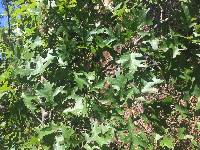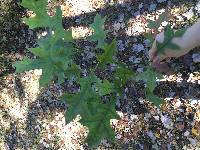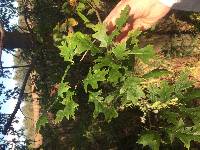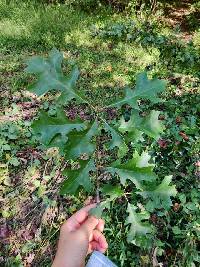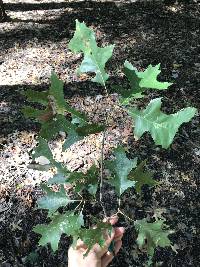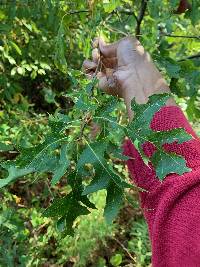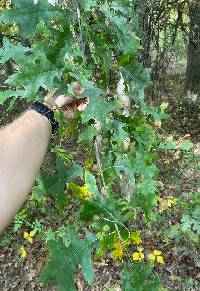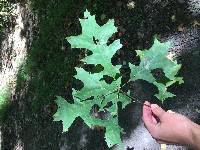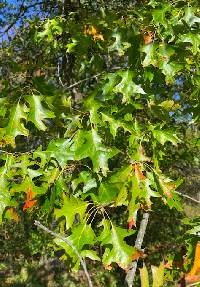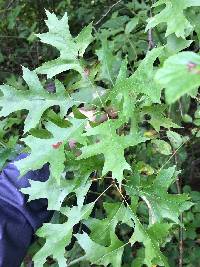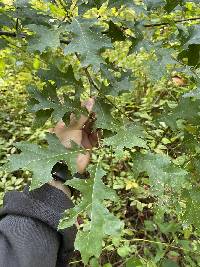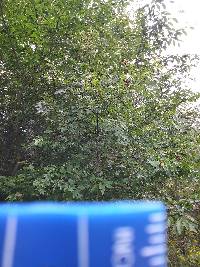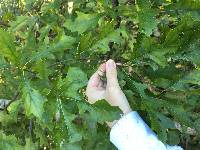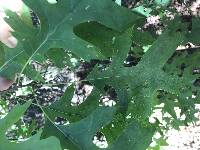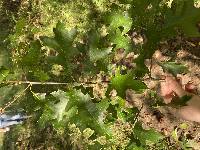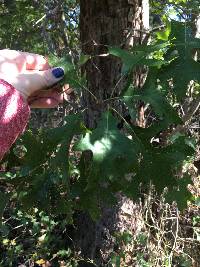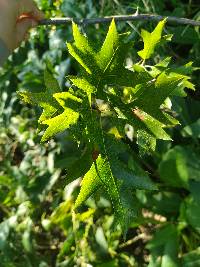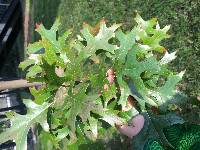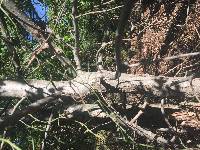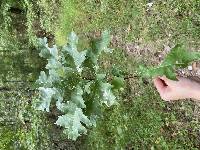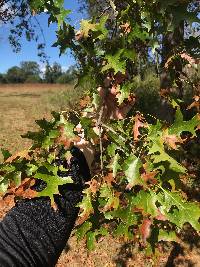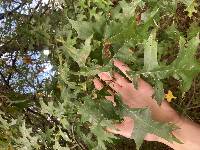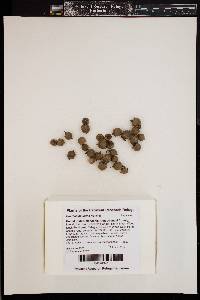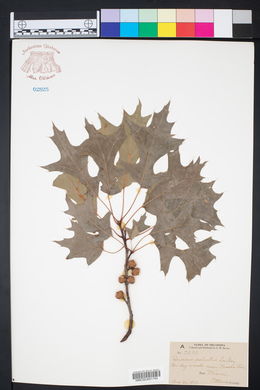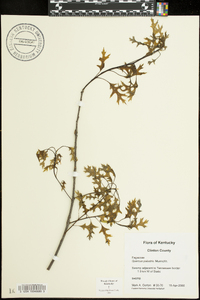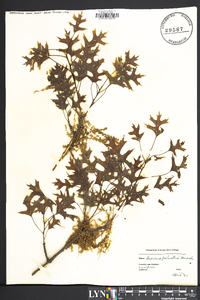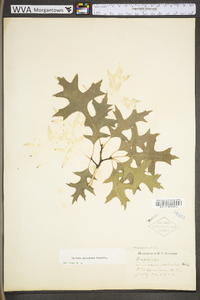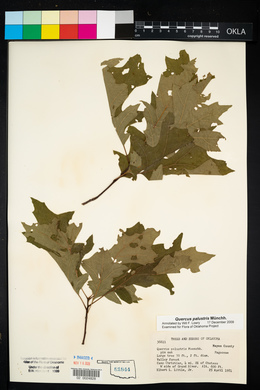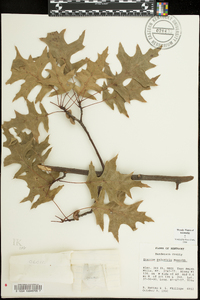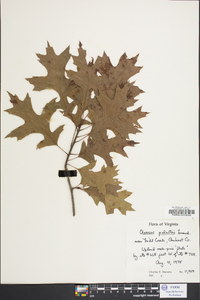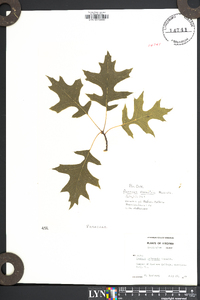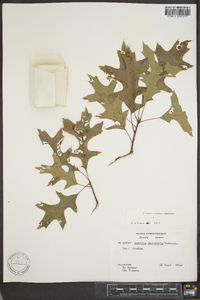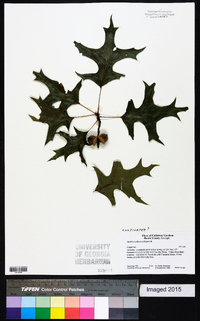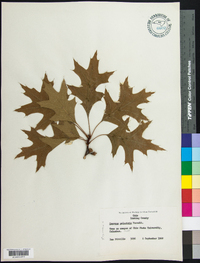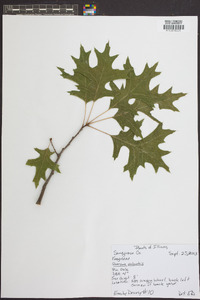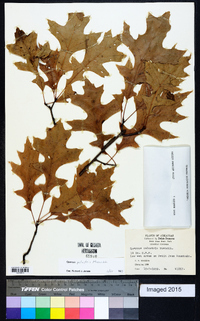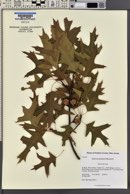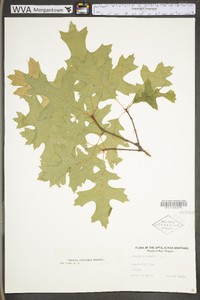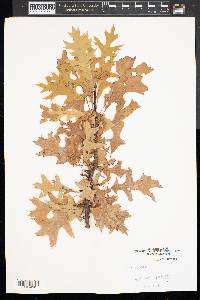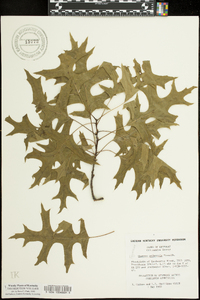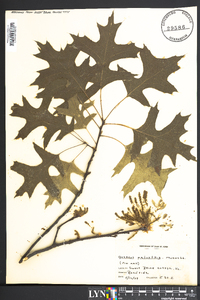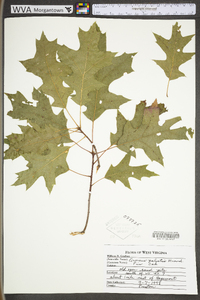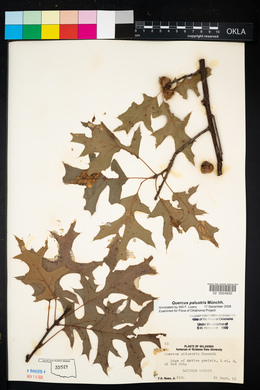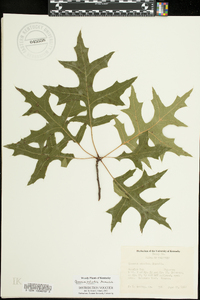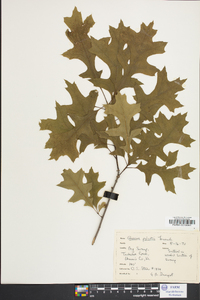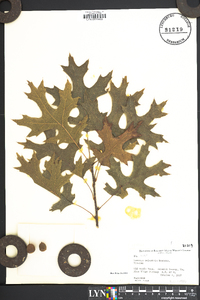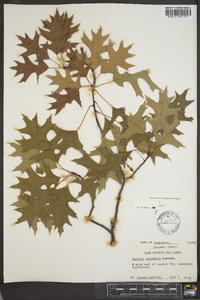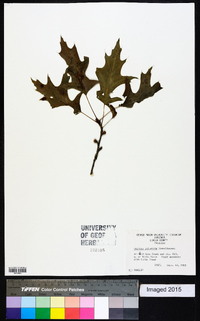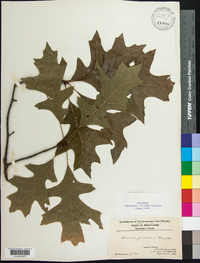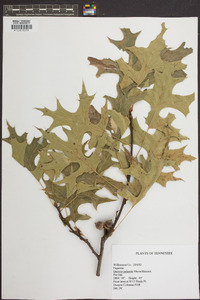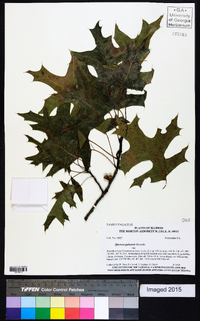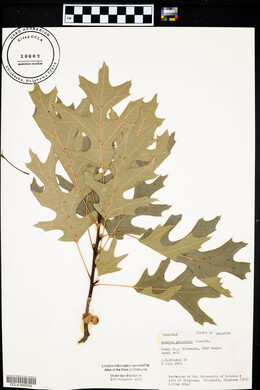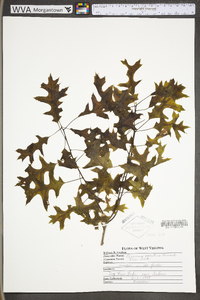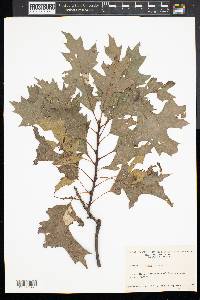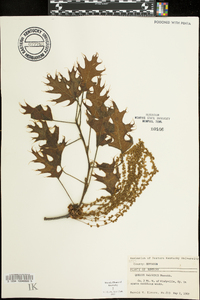Quercus palustris
|
|
|
|
Family: Fagaceae
Pin Oak
|
Trees , deciduous, to 25 m. Bark grayish brown, fissures broad, shallow, inner bark pinkish. Twigs reddish brown, 1.5-3(-4) mm diam., soon becoming glabrous. Terminal buds brown to reddish brown, ovoid, 3-5 mm, glabrous or with a few fine hairs at apex. Leaves: petiole 20-60 mm, glabrous. Leaf blade elliptic to oblong, 50-160 × 50-120 mm, base cuneate to broadly obtuse or truncate with basal pair of lobes often somewhat recurved, margins with 5-7 lobes and 10-30 awns, lobes acute or attenuate or distally expanded, apex acute to acuminate; surfaces abaxially glabrous except for conspicuous axillary tufts of tomentum, veins raised, adaxially planar, glabrous. Acorns biennial; cup thin, saucer-shaped, 3-6 mm high × 9.5-16 mm wide, covering 1/4 nut, outer surface glabrous or puberulent, inner surface glabrous or with a few hairs around scar, scale tips tightly appressed, acute to obtuse; nut globose or ovoid, 10-16 × 9-15 mm, often conspicuously striate, glabrous, scar diam. 5.5-9 mm. 2 n = 24. Flowering spring. Bottoms and poorly drained upland clay soils; 0-350 m; Ont.; Ark., Conn., Del., D.C., Ill., Ind., Iowa, Kans., Ky., Md., Mass., Mich., Mo., N.J., N.Y., N.C., Ohio, Okla., Pa., R.I., Tenn., Va., W.Va., Wis. Quercus palustris is especially common in landscape and street plantings. Its persistent dead branchlets (pins) and branching pattern (drooping lower branches, horizontal middle branches, ascending upper branches) are quite distinctive. This species reportedly hybridizes with Quercus coccinea (E. J. Palmer 1948) and with Q . imbricaria (= Q . × exacta Trelease), Q . marilandica , Q . nigra , Q . phellos (= Q . × schochiana Dieck), Q . rubra , Q . shumardii , and Q . velutina . Some Native American tribes used infusions prepared from the bark of Quercus palustris to alleviate intestinal pains (D. E. Moerman 1986).
Tree 15 - 25 m tall, trunk to 1 m in diameter Leaves: alternate, stalked, shiny dark green above, paler beneath, 7.5 - 15 cm long, 4 - 10 cm wide, rounded to almost square at the base, five to seven bristle-tipped lobes separated by U-shaped depressions reaching three-quarters the distance to the midvein, tufts of hair in vein axils. Foliage turns bronze to red in fall. Flowers: either male or female, found on the same tree (monoecious), yellow male flowers borne in hanging catkins 5 - 10 cm long, small bright red female flowers borne solitary or in small clusters near leaf axils. Fruit: an acorn, maturing in two seasons, solitary or in clusters of two to three. The stalkless or short-stalked cup is shallow saucer-shaped, covers the base of the nut, and has dark reddish brown, tightly appressed scales. Nut light brown, 1 - 1.4 cm long, almost spherical. Bark: grayish brown, smooth when young, developing shallow checkered ridges. Twigs: changing from reddish brown and slightly hairy to shiny green and smooth to gray. Buds: reddish brown, 2 - 4 mm long, conical with a pointed tip. Each terminal bud is surrounded by a cluster of lateral buds. Form: pyramidal to oval with upper branches upright, middle branches horizontal, and lower branches descending. Lower branches hold onto the trunk after death. Similar species: Many species in the red oak group have highly variable, lobed leaves with bristle tips. Quercus rubra has shallowly lobed leaves with a somewhat dull upper surface and a very shallow saucer-shaped acorn cup that covers only the base of the nut. Quercus velutina has leaves with depressions reaching half way to the midvein, inner bark that is bright yellow to orange, and fringed acorn cups that fit loosely and cover one-third to half the nut. The leaves of Quercus shumardii have depressions reaching three-quarters the distance to the midvein, the tufts of hairs at the leaf axils are very prominent, the buds are grayish to yellow, and the acorn cup is saucer-shaped and covers one-third of the nut. Quercus ellipsoidalis has leaves with depressions reaching three-quarters the distance to the midvein, dead branches remaining on the trunk, and an acorn cup enclosing up to half of the often elliptic nut. Quercus coccinea has leaves with C-shaped depressions reaching half the distance to the midvein, inner bark that is pink to red, and a reddish brown to orange acorn cup that covers one-third to half the nut, which has concentric rings at the tip. Flowering: May Habitat and ecology: Poorly drained claypan soils, floodplains, flatlands, and areas that are seasonally very wet but become dry. Occurence in the Chicago region: native Notes: Quercus palustris naturally hybridizes with Q. rubra (Q. x columnaris) and Q. velutina (Q. x vaga). Etymology: Quercus is the Latin name for oak. Palustris comes from a Latin word meaning marsh-loving. The common name, pin oak, comes from the pin-like, spur-form branchlets on the main trunk. Author: The Morton Arboretum Tree to 30 m, the lower branches ±persistent, slender, widely spreading and usually slightly declined; bark smooth, or with shallow furrows and flat ridges; mature twigs glabrous; lvs shining, paler beneath, glabrous except for the conspicuous tufts of stellate hairs in the vein- axils beneath, often cuneate at the base and decurrent on the petiole; lf-lobes 2 or 3 pairs, much longer than the width of the central body of the blade, often widened distally and toothed, bristle-tipped; upper edge of lf-lobes ±perpendicular to the midvein; secondary lf-lobes fewer than in no. 27 [Quercus shumardii Buckley]; winter-buds relatively small, acute, subglabrous; acorn-cup saucer-shaped, 1-2.5 cm wide, covering a fourth to a third of the nut, with very small, puberulent scales; nut 10-14 mm. Mostly in low, periodically flooded places, but susceptible to cult. on upland sites; Mass. and Vt. to Mich., Io., and Kans., s. to N.C., Tenn., and Okla. Gleason, Henry A. & Cronquist, Arthur J. 1991. Manual of vascular plants of northeastern United States and adjacent Canada. lxxv + 910 pp. ©The New York Botanical Garden. All rights reserved. Used by permission. From Flora of Indiana (1940) by Charles C. Deam Infrequent to common in all parts of the state. It may be absent from Benton County. It is found only in wet habitats and prefers a hard, compact, clay soil with little drainage. It is locally frequent to common in the northern part of the state and in the southern part it is abundant in the lowlands along streams and grows to great size in the low woods along the Patoka River. It is also locally common in the "flats" in the southeastern part of the state. In Indiana there are trees with two very distinct kinds of nuts. The common form has a large nut which is depressed at the top. The other has a much smaller, ovoid nut with a conical apex. I have this form from Pike and Wells Counties. …… Indiana Coefficient of Conservatism: C = 3 Wetland Indicator Status: FACW Deam (1932): Wood similar to red oak, but much inferior to it. It is tardy in the natural pruning of its lower branches, and when the dead branches break off they usually do so at some distance from the trunk. The stumps of the dead branches which penetrate to the center of the tree have given it the name of pin oak. It sometimes is called water oak, and swamp oak. For street and ornamental planting it is one of the desirable oaks to use. It is adapted to a moist soil, grows rapidly, and produces a dense shade. When grown in the open it develops a pyramidal crown. |
|
|
|

